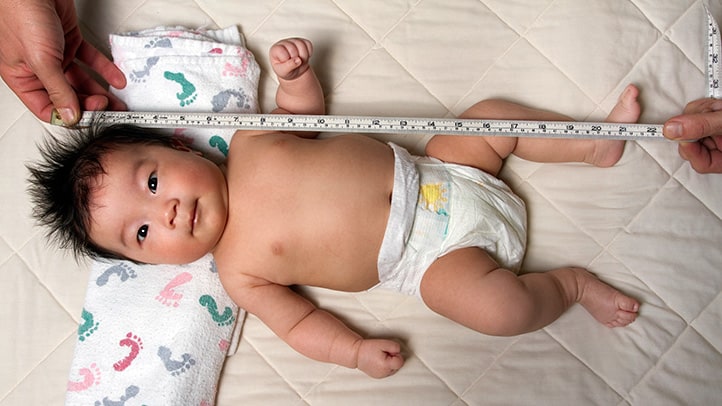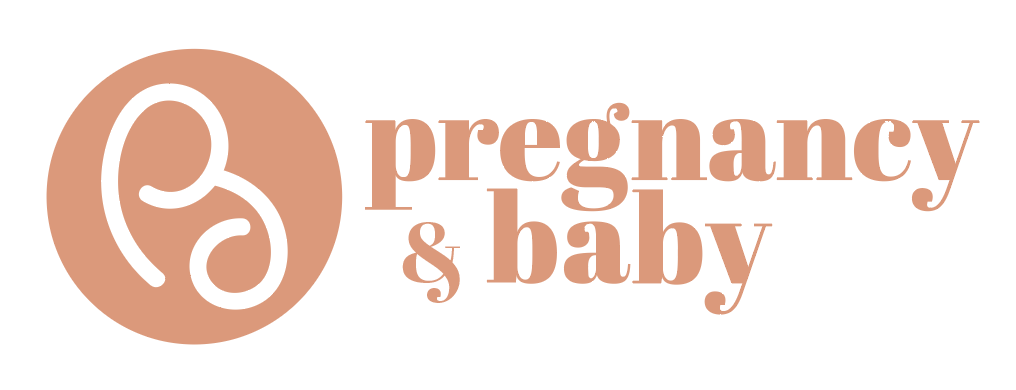The first year of motherhood can be a nerve wrecking experience. But, one of the most rewarding parts of this difficult experience is to see your little one mature and grow. And the timing of your baby’s growth spurts tends to follow a pattern.
But, when does this pattern repeat itself? When does your little one go through growth spurts? Read on and get the answers to these questions here. Here we look at when babies go through growth spurts and how you can spot them.
What Is A Growth Spurt?
A growth spurts is a sudden increase in your baby’s growth rate, and experts often link it with increased feedings. While going through a growth spurt, your baby will be hungrier than usual and act fussier than normal. He will feel more hungry and you will have to breastfeed him more frequently than normal.
Babies tend to consume more breast milk while they go through a growth spurt, and it is temporary in nature. Most breastfed babies seem to exhibit such symptoms during the first few weeks of their life. The breast milk consumption normalizes between one and six months. After six months, when you begin to wean your baby with solid foods, his breast milk consumption gradually decreases.
Growth spurts mark physical and mental developments for your baby. Your little one requires proper nutrition so that he becomes more mature and learns different growth facets like rolling over, crawling, walking or talking. In most of the time, growth spurts last for only two to three days. Try to feed your baby constantly during such phase and help him go through the development changes smoothly.
Interesting Facts About Growth Spurts:
Growth spurts occur in both breastfed and bottle-fed babies.
- The mother needs to feed her baby constantly during such phase, to satisfy hunger curbs of the little one.
- There is no definite or set time for a growth spurt, but it usually occurs during 7-10 days, three weeks, six weeks, three months, four months, six months and nine months.
- Your baby gains most of the weight during such phase.
- Growth spurts are less frequent occurrence after the first year of your baby’s life.
- The baby gains more height than weight after the first year of his life.
- Growth spurts last for only 2-3 days, but can sometimes last for a week also.
- As your baby needs more breast milk supply during his growth spurt, you need to regain your calories by drinking fluids and eating nutritious foods.
- The weight of your baby usually triples after the first year of his life.
- The height of your baby increases by almost 8-10 inches after the first year of his life.
What Happens During A Growth Spurt?
Here are some of the noticeable changes that occur during growth spurts:
- During a growth spurt, your little one puts up extra weight, height and his circumference of the head increases. He learns variant developmental activities like crawling, walking, rolling and sitting.
- Your baby gets hungrier more often and intakes higher amounts of breast milk than usual.
- Your baby acts fussier, as soon as her stomach gets empty, and you do not feed him in mentioned time frame. If you want to keep your growing baby calm, it is advisable to feed him at regular interval of time. With an adequate supply of breast milk, your baby’s growth rate is higher, and he matures at a faster pace.
- Babies going through the phase of growth spurts may not exhibit any of the noticeable signs. But you can keep a track of the growth rate, by regular monitoring of his body weight. A sudden increase of body weight clearly indicates that your baby is going through growth spurts naturally.
- When your baby goes through a growth spurt, he may need to sleep more or less than usual. Research concludes that when babies go through growth spurts that act clingy, fussy and irritable. It disrupts their sleep pattern during night-times.

Vital Data About Baby’s Growth Rate:
Let us look at the data, which help to analyze your baby’s growth rate after the first year of his life.
1. At Birth:
- Length of the newborn baby lies around 19 and 21 inches (48-53 cm)
- Weight of a healthy newborn baby falls between 7 and 7.5 pounds (3- 3.4 kg)
2. Gain In Birth Weight:
- Resumes by day 14
- Doubles by the age of 5 months
- Triples by the age of 12 months
3. Gain In Birth Length:
- Increases 50 percentage at the age of one year
4. Gain In Head Circumference:
- 14 inches (35 cm )at birth
- 17 1/4 inches (44 cm) by the age of six months
- 18 1/2 inches (47 cm) by the age of one year
5. Weight Gain First Six Weeks:
- 3/4 ounce (20 grams) per day
Continue on next page...
Is A Growth Spurt Linked With A Feeding Spurt?
Yes, they are interrelated. A feeding spurt is the phase when your baby seems hungrier than usual and needs frequent feeding. Your baby will act fussier than usual and seem hungrier than usual, in fact, even after you feed him. Mothers need to increase the frequency of feeding, for both breast milk and formula milk. For breastfed babies, the feeding can reach up to 18 times in 24 hours.
Surprisingly, a feeding spurt is not directly related to enhanced growth rate, but it helps your baby consume more calories and grow fast. For such reasons, many individuals use the terms feeding spurt and growth spurt to indicate the same thing.
Signs Of Growth Spurts In Babies:
Besides being hungrier than usual, there are some other signs of growth spurts in babies, which include:
1. Bottomless Stomach:
- One of the most significant sign of growth spurt is a large and sudden increase of your baby’s appetite.
- Your baby feeds more frequently than normal.
- Your baby requires an extra amount of calories to cope with the growth pace accurately.
- It is important for you to feed your baby at frequent intervals of time so that he fills up his appetite constantly and feels satisfied. Hunger curbs make your baby feel restless and irritable.
2. Sleep:
- Before and during a growth spurt, your little one seems sleepier than the normal days.
- Your baby wakes up lesser at nights and takes naps during the daytimes also.
- With extra sleep, the baby channels her energy for her growth processes.
- Research concludes that your baby sleeps for an excess four and half hours than usual days during a growth spurt.
- During sleep, a vital protein called human growth hormone (HGH) is produced in your baby’s brain.HGH is extremely crucial for your baby’s growth and mental development.
- But there are exceptions, where babies sleep lesser during growth spurts. In such scenario, the baby wakes more frequently at nights.
- The modification in sleep pattern during growth spurts usually varies from one baby to another. If you are confused with the sleep routine, never freak out in such situation. Hold your patience, as your baby’s routine, will be back to normal in next few days.

3. Behavior:
- During a growth spurt, your baby acts more restless, irritable and clingy than usual.
- You may notice that your baby likes you holding him all the time and starts crying as soon as you put him into the bed or crib.
- Your baby easily becomes weepy, when he lays back in his bed alone.
4. Change In Feeding Routine:
- During a growth spurt, there is a slight change in your baby’s feeding routine.
- You may notice that your little one feel hungrier more often and want to feed at different times during the day and evening.
5. Your Baby Gains Weight Rapidly:
- During a growth spurt, your baby intakes extra amount of calories that are essential for his body growth and development.
- Your baby gains body weight significantly during the first year of his life.
- Doctors advise that you weigh your little one every month. It helps to keep a track of your baby’s growth rate.
Changes To Observe During Different Phase Of Growth Spurts In Babies:
1. At Two Weeks:
- Your baby is still too little, but their eyes seem to look with intense concentration.
- Keep your face at a distance of 25 cm, and start communicating with your little one. Establish a skin to skin contact that helps you to bond with your baby. Your baby tends to sense your body temperature and feel normal.
- Once your baby starts putting up his body weight, you can expect to see the gain of around 25g per day.
- You will notice that your baby grows faster and discover that his tiny nails are growing too.
- Your baby will probably sleep for up to 18 hours a week but in a random fashion.
2. At Three Weeks:
- By now your baby starts looking a bit more like you and his skin appear pinkish and a bit plumper.
- By the end of the third week, your baby tries to lift her head and move it from one side to other.
- You can roll up a soft towel under his chest and help him get started with small lifts. His nervous system and muscle control mature slowly, and her movements become jerky.
3. At Six Weeks:
- Your baby becomes more attentive and awake, and his senses start turning more sensitive than the earlier days.
- Your baby develops his sensory glands and now able to hear, see, smell and taste. But he can only express his senses through screaming and crying.
- You can notice signs of growth spurts during the sixth week of your baby’s life. As your baby senses different notions, he becomes more restless and cries whenever feels hungry.
- During this phase, your baby smiles more and cries with real tears.
4. At Three Months:
- In this phase, your baby seems to recognize you and acts shy in front of strangers. He starts to establish a close bonding with his parents.
- Your baby cannot sleep well and starts to distrust strangers or unknown family members. Above all, your baby reacts negatively when either of the parents is not around him.
- Your little one gets better at moving around like crawling and motor coordination. He can sit, hold toys in his small hands, put a finger in his mouth, listen to music, understand simple commands, and clap hands or wave good-bye.
5. At Six Months:
- By now, your baby has reached to double his birth weight. At six months, the growth rate of your baby slows down to about one pound a month. The gain of height also allows down to about half-inch each month.
- At this age, your baby learns to sit independently and uses both his hands to offer support to elevate his body.
- Your 6-month-old baby can easily roll from his back to his stomach and vice versa.
- The sleep time of a six-month baby varies from six to eight hours. But if your little one finds trouble sleeping, it is better to consult the pediatrician immediately.
- The risk of SIDS is quite lower at six months than it was during the first few months of your baby’s life.
- You can include solid foods during this phase of your baby’s life. You can include iron-fortified cereal, strained fruits, and vegetables. If your baby seems allergic to a certain food group, eliminate those from his diet.
- Your baby learns to communicate at this tender age. So read story books, sing songs and try to communicate with him.
6. At Nine Months:
- At nine months, your baby tends to become an expert crawler.
- At nine months, your baby rapidly changes his position. He can push to attain the crawl position, sit back down or bend forwards to pick his toys.
- During this phase, your baby’s brain develops progressively. Try to create a positive environment and help your little one learn interesting things through educational videos and games.
- Your baby can now utter some words like Pa, Ma, Dada and many more. Your baby also understands your instructions and responds to them accordingly.
- Hold your baby’s hand and help him stand on his feet, so that he learns walking effectively.
Continue on next page...
Effective Ways To Deal With Growth Spurts In Babies:
Here are some of the helpful tips that guide parents to deal with growth spurts and keep babies calm during the sensitive phase:

1. Breastfeed Your Baby At Regular Intervals:
- Your baby becomes fussier or irritable as soon as he curbs for hunger during a growth spurt.
- Try to offer him the extra feeds and satisfy the hunger prangs fully.
- Your baby’s body requires sufficient amount of nutrients for growth and development. Through regular breastfeeding or formula milk, you can supply those vital elements and help your baby grow faster.
- To increase your milk production rate, it becomes essential to drink lots of fluids and intake nutritious foods.
- If your baby is formula-fed, and he immediately feels hungry after a feed, you can give him an extra bottle.
2. Dealing With Disturbed Sleep Pattern:
- Growth spurts often lead to disrupt the sleep pattern of your baby, while he quickly gains weight and grows.
- During the specific phase of growth spurts at two weeks, three weeks, six weeks, three months, six months and nine months your baby develops unusual sleep patterns.
- If your little one sleeps more during nighttime, no need to wake him up. Most of the growth hormones releases in the body during the night. So it is better if your baby sleeps longer in the nighttime.
- If you notice that your baby wakes at regular interval of time, try to feed him breast milk.
- If your baby sleeps for too long in the daytime, at nights he acts restless and cries constantly. Try to keep him awake during daytime and play engaging games. Keep the naps during daytime short and sweet. Keeping your little one active during the daytime helps him to sleep through the entire night.
3. Dealing With Unpredictable Eating Habits:
- If your baby sleeps more than usual and wakes up early in the morning, keep yourself available for breastfeeding when he wakes up. If you have to go somewhere out, consider pumping your breast milk and keep the bottle ready for your baby.
- Because of a growth spurt, your baby gets hungry at random hours of the day. But try to establish a feeding routine, which also involves naptime. When your little one gets habituated with the feeding and nap times, he acts less cranky.
- If your baby appears to drink more breast milk than normal, do not restrict him from feeding. His growing body requires enough quantity of nutrients during the growth phase. You should not feel frightened that your breast milk will run out. When your baby demands more breast milk, your body tends to adjust the occasion and fulfill his requirements adequately.
- Your baby’s appetite decreases depending upon how he deals with his growth spurt. Remember to feed him at regular time intervals and provide the right amount of milk (breast milk or formula).
- After inclusion of solid foods, try of make him eat fruits, vegetable, eggs and meat during his growth spurt.
4. Dealing With Unpredictable Emotions:
- Bottle-fed babies tend to act crankier and cry more often, as soon as they feel hungry. In such circumstances, try to control your child’s emotions by soothing him with other objects. Such items may include a pacifier or stuffed animal.
- Dealing with your screaming and the fussy baby becomes difficult for you. Try to remember that your baby is going through stressful life phase and your have to offer complete parental support to him. Stay calm and try to handle your baby in a peaceful manner. Do not shout or scream unnecessarily. Try singing tuneful music to soothe your little one.
- During a growth spurt, show extra affection to your baby. Cuddle, hug and show affection towards your little one so that he easily comes out of crankiness.
Keeping Track Of Your Baby’s Growth Spurt:
- To keep a close track of your baby’s growth rate take him to the pediatrician on a regular basis. The medical practitioner examines his body weight, and length band help you keep a complete track of your baby, during the growth spurt.
- You need to remember that the growth chart is used to track the pattern of growth in your baby. If the result lies within the normal range, then stay assured about your child’s growth rate. However, if the growth appears stunted at some stage, consult the pediatrician as soon as possible.
- Instead of getting frustrated with your baby’s tantrums and crankiness, try to deal with the situations effectively. From birth to one year of age, your growing baby adds up to 10 inches (25.4 cm) in length, and his weight gets three times his birth weight.
Subscribe to our mailing list and LIKE US to receive our latest updates!
Article written by Ria Saha







